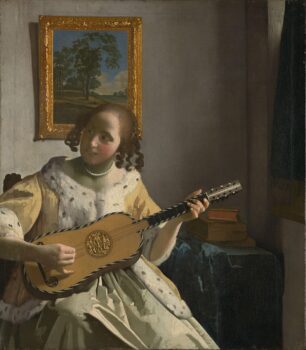Meaning Of The Guitar Player by Johannes Vermeer
Johannes Vermeer, one of the most celebrated painters of the Dutch Golden Age, left behind a modest yet profoundly influential body of work. Among his approximately 34 known paintings, “The Guitar Player” stands out as a luminous and intimate portrayal of music, femininity, and domestic tranquility. Painted around 1670–1672, this artwork is an exquisite blend of technical mastery, symbolic depth, and emotional subtlety.
This post delves into the meaning and analysis of The Guitar Player, exploring who Vermeer was, how he painted this masterpiece, what the painting represents, its symbolism, the story it tells, its style, monetary value, and where it resides today.
Who Was Johannes Vermeer?
Johannes Vermeer (1632–1675) was a Dutch painter from Delft, known for his serene and meticulously crafted genre scenes depicting domestic life. While relatively obscure during his lifetime, Vermeer is now regarded as one of the greatest painters in Western art history. His works often explore light, space, and the quiet drama of daily life.
Vermeer’s paintings are known for their photorealistic clarity and emotional subtlety. He was a master of light and often employed complex compositional structures and the camera obscura, a device that projects images, to achieve precise perspective and atmospheric effects. His focus on women engaged in intimate moments of music, reading, and contemplation offers a timeless glimpse into the private realms of 17th-century life.
Overview of The Guitar Player
Title: The Guitar Player
Artist: Johannes Vermeer
Date: Circa 1670–1672
Medium: Oil on canvas
Dimensions: 53 x 46.3 cm (20.9 x 18.2 in)
Current Location: Kenwood House, London, United Kingdom
Owner: English Heritage (Iveagh Bequest)
The Guitar Player captures a young woman joyfully strumming a guitar. She is adorned in a luxurious yellow satin dress, seated in a softly lit interior. Her gaze is directed toward the viewer, creating a dynamic interaction that distinguishes this painting from many of Vermeer’s other introspective female portraits.
What Is Happening in The Guitar Player?
In this painting, a young woman is caught in a moment of musical engagement. Her fingers are poised over the strings of a baroque guitar, an instrument that was gaining popularity in the Netherlands during the 17th century. Her face is turned slightly, her expression a mix of joy and focus.
Behind her, we see part of a framed painting on the wall (possibly a landscape), a hint of a chair, and softly illuminated wall textures. The room feels elegant yet understated. The woman’s vibrant yellow dress gleams in the light, contrasted against the darker backdrop, creating a strong sense of three-dimensionality.
The interaction between the viewer and the subject is particularly notable. Unlike other Vermeer women who are often lost in thought or engaged in solitary activity, this woman acknowledges us. Her slight smile and direct gaze suggest we might be part of this private moment, perhaps an unseen guest or listener.
How Was The Guitar Player Painted?
Vermeer employed oil on canvas, using delicate layers of paint to achieve his signature smooth textures and lighting effects. He was particularly adept at using glazing techniques, where multiple translucent layers of paint are built up to create depth, luminosity, and realism.
It is also widely believed that Vermeer used a camera obscura to assist in achieving accurate perspectives and realistic light falloff. While no conclusive evidence proves this, certain optical effects, like the subtle blurring in parts of The Guitar Player, suggest he may have experimented with such devices.
The precision of the lace details, the highlights on the guitar strings, and the reflective shimmer of the woman’s dress demonstrate Vermeer’s acute observation and meticulous technique. He often mixed expensive pigments, such as ultramarine made from lapis lazuli, and spared no cost in capturing the richness of fabrics and furnishings.
Artistic Style and Genre
The Guitar Player belongs to the genre of Dutch genre painting, which focused on scenes of everyday life. However, Vermeer elevated this genre into something poetic and timeless. His style is often categorized as Baroque, but with an inward, contemplative focus rather than the grand drama seen in Italian or Flemish Baroque works.
Stylistically, the painting is part of Vermeer’s late period, during which he began to adopt more dynamic compositions and brighter palettes. This painting’s liveliness, both in subject and color, marks a departure from his more restrained earlier works like The Milkmaid or Woman in Blue Reading a Letter.
It also reflects the influence of Caravaggism, particularly in the use of chiaroscuro, strong contrasts between light and dark, to model the subject and draw attention to key elements like the woman’s face and guitar.
Symbolism and Deeper Meaning
On the surface, The Guitar Player appears to be a lighthearted scene, but like many of Vermeer’s works, it brims with symbolic undertones:
1. Music as a Symbol of Love
In the 17th century, music was frequently associated with courtship, romance, and harmony. The presence of a musical instrument, especially when played by a woman, often hinted at amorous themes. The woman’s inviting gaze, combined with the intimacy of the setting, may suggest that she is playing for a suitor, perhaps the viewer themselves.
2. The Guitar as a Modern Instrument
The baroque guitar was a relatively new instrument in the Dutch Republic, symbolizing modernity, sophistication, and worldly knowledge. Unlike the more traditional lute, the guitar had a lighter, more joyful sound. Its inclusion here may reflect the sitter’s fashionable tastes and cultural refinement.
3. Feminine Autonomy
Vermeer’s women are often portrayed in roles that emphasize interiority, intellect, and agency. This woman is not merely decorative; she is an active participant in her world, engaging directly with the viewer and producing music. This portrayal challenges passive stereotypes and elevates the subject’s individuality.
4. Light as a Symbol of Enlightenment
The way light suffuses the room, catching on the fabric and skin, might also symbolize knowledge, clarity, and grace. Vermeer frequently used light not just as a technical tool, but as a metaphor for emotional or spiritual revelation.
What Does The Guitar Player Represent?
The Guitar Player represents a celebration of music, youth, and domestic elegance. It reflects a world of refinement and peace, an idealized version of the Dutch bourgeois interior. The painting captures a fleeting moment of pleasure and engagement, but beneath the surface lies a complex interplay of symbolism, gender, and cultural values.
It also represents Vermeer’s interest in the sensory world, particularly the visual and auditory. Through this painting, he invites the viewer to not only see but imagine hearing the soft notes of the guitar, creating a multi-sensory experience that transcends time.
The Woman in the Painting: Who Was She?
As with most of Vermeer’s works, the identity of the woman remains unknown. However, art historians have speculated that the same young model appears in several of his later paintings, such as The Lacemaker and A Young Woman Seated at a Virginal. Some even believe she may have been Vermeer’s daughter.
Her confident demeanor and fashionable attire suggest she belonged to a well-to-do family, possibly Vermeer’s own social class. The painting thus becomes not just a portrait, but a character study, a synthesis of elegance, charm, and musicality.
Where Is The Guitar Player Located Today?
The Guitar Player is housed at Kenwood House in London, a neoclassical villa located on the edge of Hampstead Heath. It is part of the Iveagh Bequest, a collection donated to the British nation by Edward Guinness, 1st Earl of Iveagh, in 1927. The painting is under the stewardship of English Heritage, and is displayed in the house’s opulent interiors, where it continues to captivate visitors from around the world.
How Much Is The Guitar Player Worth?
Although priceless in artistic terms, if The Guitar Player were ever to be sold on the open market, which is highly unlikely, it would command an astronomical price.
Experts estimate that a genuine Vermeer today would fetch well over $200 million, possibly rivaling or exceeding the prices of works by Leonardo da Vinci or Vincent van Gogh. The rarity of Vermeer’s output, combined with his posthumous acclaim, makes his paintings among the most valuable in the world.
In 2004, another Vermeer, Young Woman Seated at a Virginal, was valued at around $30–50 million, a figure that has likely tripled or quadrupled by now, considering art market inflation and growing demand.
The Guitar Player Legacy and Influence
The Guitar Player remains one of Vermeer’s most admired and beloved works. Its influence is evident in countless homages by later artists, photographers, and filmmakers. The painting’s graceful composition and emotional immediacy continue to resonate with contemporary audiences, reminding us of the enduring power of quiet moments.
It is also frequently referenced in discussions of feminist art history, due to its depiction of a woman not as a passive object, but as an active, self-aware subject.
In music, literature, and film, The Guitar Player has inspired interpretations ranging from romantic to psychological. It appears in documentaries, novels, and art history textbooks as a quintessential example of Vermeer’s genius.
Why The Guitar Player Still Matters
The Guitar Player by Johannes Vermeer is more than a painting, it’s a window into a world of harmony, intimacy, and radiant beauty. Through the lens of this single figure in a sunlit room, Vermeer speaks across centuries about the joy of music, the richness of domestic life, and the complexity of the human gaze.
It is a masterclass in composition, symbolism, and subtle storytelling, offering viewers not just a scene, but an experience, a moment of musical enchantment frozen forever in oil and light.
In a fast-paced, hyperconnected world, The Guitar Player reminds us of the beauty found in stillness, and the profound narratives that unfold when we simply stop, look, and listen.




